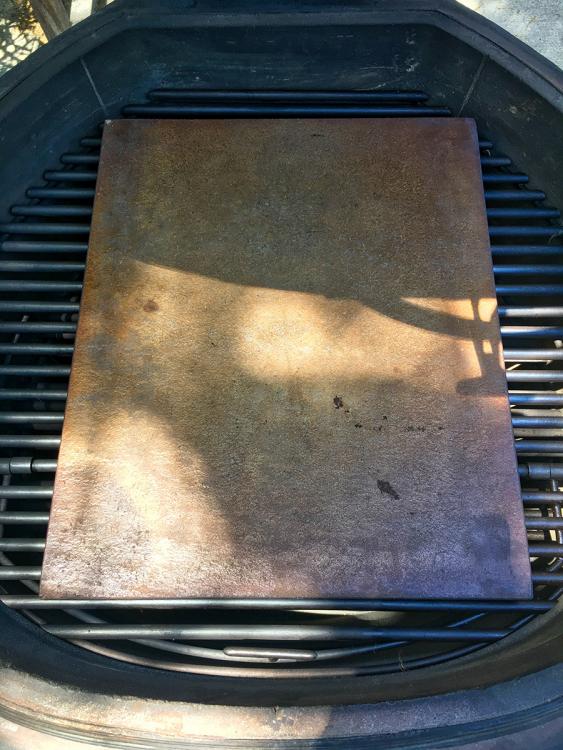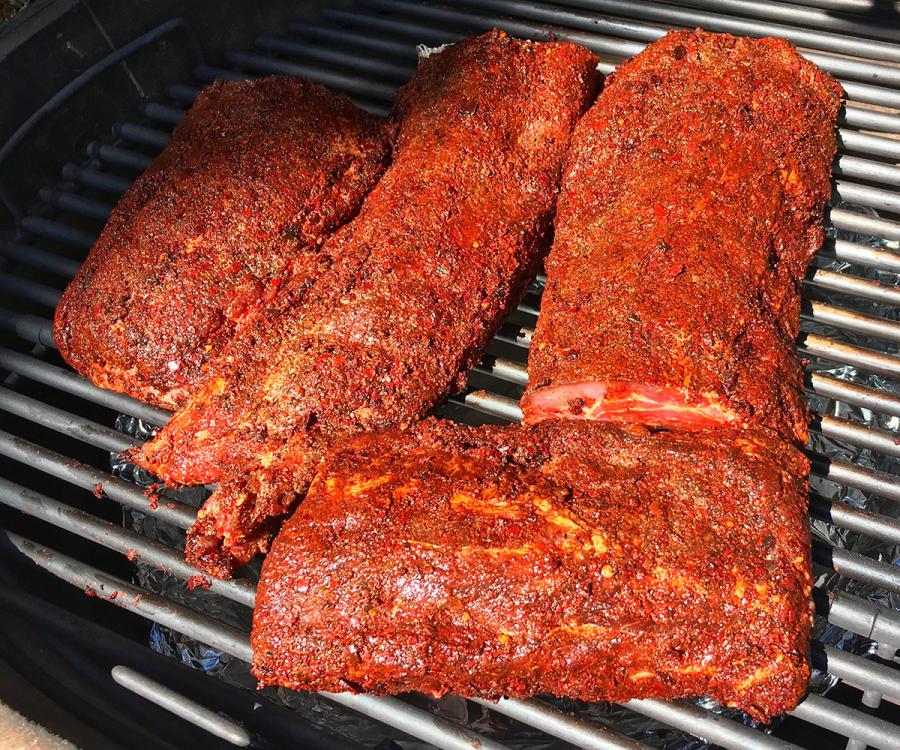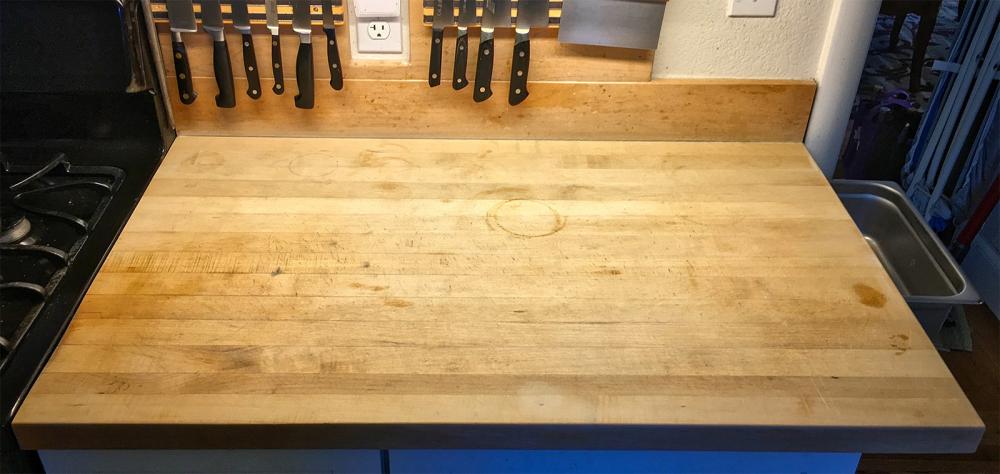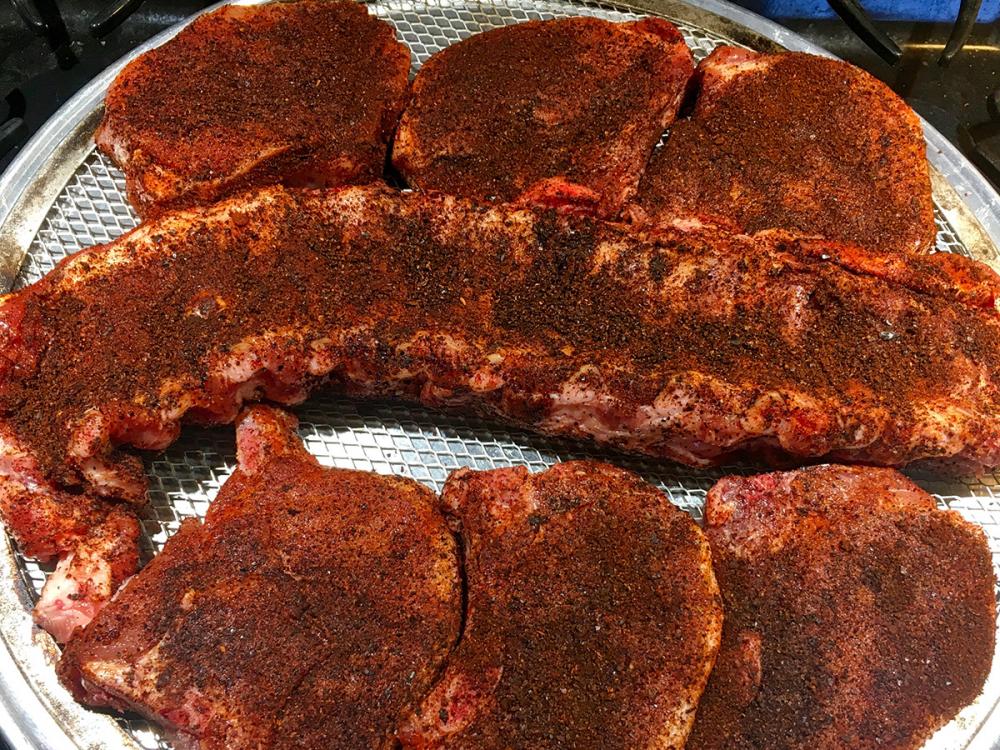-
Posts
1,738 -
Joined
-
Last visited
-
Days Won
53
Content Type
Profiles
Forums
Events
Everything posted by Syzygies
-
This is a picture of a roast. The conference was for my (belated) 60th birthday along with my coauthor Mike Stillman. We're being roasted. I'm on the left; Mike is next in the red shirt. (Just now on the phone I had a great conversation with Dennis.)
-
We had this exact cut Sunday for 12, along with brined, apple-smoked Salmon on a bed of basil. Our execution was in the spirit of this recipe, with more precise measurements and equipment. Despite lots of other food, there was none left. I untied and opened up a five pound prime rib roll, and trimmed away absolutely all fat and silver skin that wasn't integral marbling. I ended up with three pieces. Weighing each piece separately, I salted 1%, peppered, and put in the fridge overnight on a rack to breathe. A few hours before serving, I vacuum packed each piece, and put into a 132 to 134 F sous vide water bath. I set up a Dennis coffee charcoal fire in our small Weber kettle (the KK was busy with the salmon). Before serving, I seared all sides over the fire, and sliced into a prewarmed La Chamba clay serving dish. Using this protocol, we've come to recognize that the fat one can trim away serves no reasonable purpose, and the geometry of the pieces is irrelevant. Trimming hours in advance, one can take one's time without penalty, exposing more surface area for the dry rub and the eventual sear. There could be those who cling by custom to preserving the roll shape and discrete fat, but we're absolutely sold. This is unquestionably the best steak we know how to serve to groups, by a robust protocol one simply can't screw up, no matter how distracting the party has become.
-
Still, four or more hours in a light brine (half cup sea salt per gallon, less sugar) makes a dramatic difference. Now one of the house rules (like "always smoke using a smoke pot") articulated by the woman in charge.
-
My Fibrament-D baking stone happens to be 13" x 16" x 1" (special order $78 in 2014). It does not fit on the upper grates (lid won't close), but it fits with room to spare on the main grates. I chose this size to match a kiln stone of these dimensions, with the wrong thermal characteristics. 14" x 16" x 1" is a standard size they cut down for me. This stone is ideal for two loaves of bread side-by-side; a round stone is better suited to pizza. I own 15" diameter round Baking Steels on both coasts. For my New York apartment I custom ordered 1/2" thick, which weighs nearly 30 lbs. For California I went 1/4" thick so my wife could lift it. The difference in baking performance is modest but real. Any eBay knockoff promoting even thinner steels will be happy to tell you how little this matters. A 16" diameter round would be ideal for the Komodo Kamado, but just too big to fit in an indoor oven. Better to maintain flexibility (these also make awesome griddles for flatbreads such as homemade English Muffins). So my advice is to buy a 15" diameter baking steel, as thick as you can stand lifting and paying for.
-
Yes. However affordable steel plate has what can generously be described as a "compound" surface. When Baking Steels were first introduced, there was a flurry of posts on the web describing how to completely clean a generic steel plate down to bare metal, before seasoning it properly. I decided that Baking Steel was worth the price. I can't speak to the food safety of whatever surface coating is left on if one is oblivious to this issue, and it's not clear by what mechanism harm would be imparted to a pizza crust. In my business however (mathematician), lack of imagination is not an accepted form of proof. I do know that galvanized metal is toxic in a cooker, so the question at least deserves to be asked. Lead glazes for storing wine helped bring down the Roman Empire, and recent cases of botulism among Eskimos are usually due to swapping in modern plastics while fermenting seal meat and such. These are both great examples of evolutionary pressure, still working. Always think twice before engaging in a novel food handling procedure, if one doesn't want to qualify for the Darwin Awards.
-
คุณเห็นรูปลักษณ์บนใบหน้าของเขาหรือไม่? ชาวอเมริกันมักคิดว่าเรากำลังคุยเรื่องกายวิภาคของพวกเขา คุณรู้ไหมว่าเขาไม่จำเป็นต้องผ่าตัดถ้าเขากินข้าวเหนียวมากกว่านี้!
-
-
Yes, a green/blue egg is certainly an Araucana egg. They were popularized in Berkeley by e.g. Cafe Fanny (now-closed part of Chez Panisse diaspora), and they fetch the best price in New York City's Union Square farmers market. Mostly, for the novelty. Many factors make big differences in yolk quality, but shell color (or breed, for that matter) isn't so significant. More relevant, do the chickens get to eat bugs? The best chicken coop setup keeps moving the coop across a grass field also used by grazing animals, as described e.g. by Michael Pollan. Araucana chickens aren't that popular in home coops, because they don't have the greatest temperament, and they're flyers: Unless you clip their wings, no fence will hold them. There are chickens that lay deep chocolate brown eggs, a far rarer sight. I'd look for those if I were raising chickens. Instead, I take care of neighbor coops.
-
-
In my house I'd be able to put those three cutting boards anywhere I wanted. (Though I might also hear about it. Laurie wouldn't be able to lift them. )
-
Where I grew up, people would put plastic seat covers on their cars, to protect the resale value. They would use coasters on their furniture. They would outfit their kitchens with fancy countertops that were useless as work surfaces, then buy these things called ... cutting boards. Huh? Why couldn't people let the original object serve its natural purpose? In my thirties I decided I wanted to be a better cook, so I took dozens of lessons with a French chef in NYC. He had a butcher block for his countertop. I'm not sure he owned a cutting board. Now, we have two butcher block countertops in California, and one in New York. Shown is my savory station in California (Laurie has a similar baking station). The overhang is useful for anything that clamps (pasta maker, meat grinder). A steam table insert slides in to the right (shown), for collecting food scraps for our compost pile. Later, I clean this countertop with water (bit of soap, then rinse) and the bench scraper, scraping into the now-empty steam table insert. (In New York, I designed my kitchen so I could scrape directly into an open dishwasher, about to run.) Let's be honest about what makes a good cook. Wanting to be a good cook is crucial, as is lots of practice. Few people ever cook better than their ability to taste, a hard limit we can do little about. However, dexterity is key. Transforming a mess of raw ingredients into a meal is a computational problem, an engineering problem, bottlenecked by the efficiency with which one can process ingredients. I find it agonizing to watch someone prep food with a small knife, because they're afraid of bigger knives. I find it agonizing to watch someone try to chop ingredients on a small cutting board. They never get a full motion going, they're always pulling their punches so food doesn't go flying off the board. It's like they're trying to dance in a gym locker. Then they have to clear the board for the next item, wasting time moving ingredients and dirtying more containers to hold them. I feel like I'm watching someone cut their lawn with a pair of scissors. Having working countertops is radically transformative to one's cooking. (I do love those three cutting boards. I particularly covet that massive round block, the same lust that lead me to wanting a house made of butcher block. Shown above is our compromise.)
-
I believe the term of art is "hunting squirrels with a bazooka". It depends how you feel about squirrels. There are times when I really want to buy 20 minutes. This is like a hairdryer, except one doesn't need the heat, and one doesn't have to hassle a cord. Of course, there's the pyromaniac factor, that drew us to fire for a million years. And drew dogs to us. And look how that worked out!
-
Yes, that is generally how I plan to use my Milwaukee blower. I like that it's cordless, and infinitely variable. Before this I was creating towering infernos in 30 seconds with a small shop vac, but that was overkill.
-
At the time I recognized this as a pointless exercise; I was playing. This was a fortuitous pointless exercise, because when I then used the Guru port to introduce a large volume of air, I got away with it.
-
After cleaning ashes with a brush, I wore a dust mask and played with my new blower, to get the inside of my KK spotless. Then, setting up an extruded coconut ring around a piece of coffee charcoal, under an apple-filled smoke pot (for salmon on a bed of basil), I noticed that the fit is pretty good to blow air into the guru port. Got my fire to speed in a nice hurry.
-
Arbitrary flow control, 3 position switch and feathering the on button. Da bomb for starting fires. Tool only shown; takes M18 system battery.
-
Start with your sharpening kit. Spend what's left of your budget on the knives themselves. There are many approaches, but Shapton GlassStones get my Fujitake VG10 Chef's Knives twice as sharp as I thought possible. Check the hardness on your knife steel; there's a separate line for traditional, softer Japanese carbon steel knives, but these stones are suited for modern Japanese knives, and also work far better than traditional Japanese water stones on western knives like Wüsthof. That frustration, trying a waterstone you bought in your twenties on a western knife? It wasn't you. I rarely use the 1000 stone, working instead 2000, 4000, 8000 as my knives need refreshing. The 1000 is useful for reclaiming a dull or western knife. I believed the same for the 500 stone, and I rarely use it, but it's heavily discounted if one buys the set. Then, of course, who cuts the barber? One absolutely needs a diamond stone to flatten and clean the water stone surfaces every time, or one is missing out on most of the performance. $476 for the 2000, 4000, 8000 and both accessories, or $547 ($71 more) to include the 500 and 1000 stones. Shapton GlassStone 500 Grit ($55) Shapton GlassStone 1000 Grit ($63) Shapton GlassStone 2000 Grit ($71) Shapton GlassStone 4000 Grit ($80) Shapton GlassStone 8000 Grit ($113) Shapton Glass 4pc Set 500x, 1k, 4k, 8k ($264) Shapton Sharpening Stone Holder ($116) Atoma 1200x Diamond Plate ($96)
-
@golfingfool I cook with parchment paper for other purposes. On the KK, it's the safest way to transfer a pair of unbaked bread loaves from the kitchen to the fire (using a pizza peel). I was taught to steam fish en papillote by making an airtight package with parchment paper; the paper traps steam as the fish bakes. So would aluminum foil. So would white parchment paper, though I don't know that the white parchment paper is even food-safe when heated; the coating on white parchment paper was never designed to take heat, though it might. Pink parchment paper is lousy for en papillote, because it passes some but not all of the steam. This is exactly why people prefer it for barbecue. If you're happy with parchment paper, you'll probably be even happier with pink butcher paper. Here is my Amazon source for pink butcher paper, $37 for 150'. Pink/Peach Butcher Paper Roll 24" X 150' in Durable Carry Tube, FDA Approved, MADE 100% in the USA, The ORIGINAL meat smoking paper for Texas style BBQ
-
It's like pushing all the buttons in an elevator, only this elevator is like that scene in Being John Malkovich, all the buttons say "at". @mguerra One needs to type "at" then start typing a user, and wait for the pull-down menu to select said user. Otherwise one gets text, no highlighting, no notification. In my experience (Chrome on Mac) very buggy, editing can hang, harder to enter return for a new line, necessary to save and edit some more. There is probably (what I observe, not what I've read) a limit of one user per post that one can tag in this way. @tony b I can get around this by editing again. Perhaps it's one tag per edit? @Stile88 not for everyone. For you? @ckreef my second tag in same editing session. Sometimes one can? Buggy. @Syzygies and of course one can tag oneself. When I first learned the programming language APL, there was an operator that deleted other functions. Of course it wouldn't work on itself.
-
We're discussing low consequence science, and I have no doubt that you cook spectacularly well (and I would love to test this assumption if I ever get the chance!). However, anyone can cook better; that's what keeps us excited by the process. You would question the scientific approach in your statement if you substituted "surgery", "late 18th century", and "sterilization", and if you were the patient. For me, it is high consequence when I find myself thinking similar thoughts, because I fear aging. While I have a family history of brain hardware failure, I fear the software failure that can come first. Have I lost interest in revisiting questions I thought I had settled? As a mathematician, that would be career-ending. I came into BBQ in a period when "3:2:1" ribs were all the rage, the conventional norm and the unquestioned advice given to all newcomers. I basically did nothing but experiment in my first several years with a ceramic cooker, and I thought that foiled barbecue was absolutely wretched. One might as well use a crock pot. Much later, when Aaron Franklin's book came out, I was struck by his careful use of pink butcher paper. I made new experiments, and came to appreciate it. There's a parallel here with sous vide. Many people just don't see the need for it. The best cooks I know can outdo sous vide for traditional applications like steak, if they bring their A game with absolutely undivided attention, and nothing goes wrong. Any idiot can achieve better results than before with sous vide. So why would anybody want to be "any idiot" when we all aspire to be masters of technique? Life happens. I also need to fit in two errands, one of which becomes an unexpectedly long distraction. My guests are two hours late. That sort of thing. It is good to know robust techniques, over techniques that are superior in ideal circumstances. An MLB baseball season is 162 games; everything that can go wrong, will, and robust techniques win pennants. Aaron Franklin needs to hold finished barbecue for varying time intervals. We can't always count on guests that are ready to eat, to the minute, when I say the barbecue is done. I love how pink butcher paper holds barbecue. I recently included one rack of ribs as a teaser appetizer for a gumbo party, where I was already using my KK for other ingredients. The gumbo required all of my attention, and the meal timing was uncertain. While I prefer fairly plain ribs (no sauce with jars from the pantry to mask inferior pork) cooked never wrapped, here I wrapped in pink butcher paper for the last hour or two. These were the best ribs I've ever cooked.
-
By convention the white paper is wax coated, and the pink is not. Imagine how confusing it could be without such a convention?
-
I wasn't familiar with baking soda in rubs; I found this page informative: How should baking soda be used to tenderize meat?
-
I'll be smoking some pork chops and Catalan sausages for Creole Gumbo. Overnight "dry-brine" (rub to us) as advocated by Justin Smillie's Slow Fires.
-
My favorite pork chops are from The Local Butcher Shop, sous vide five hours at 136 F with 1% sea salt, Madagascar black pepper and agridulce pimenton, then finished quickly over coffee charcoal. I get flareup I'd like to minimize, so these greats look interesting.
-

Is this an American thing/Northeast thing?
Syzygies replied to Garvinque's topic in Jokes, Ribbin' & Misc Banter!
My New England cousin used to put ketchup on her eggs, when she was a kid. That passed for novelty, when I was a kid. Sriracha would be better. Or a good homemade harissa.








